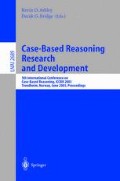Abstract
This paper presents a framework for Historical Case-Based Reasoning (HCBR) which allows the expression of both relative and absolute temporal knowledge, representing case histories in the real world. The formalism is founded on a general temporal theory that accommodates both points and intervals as primitive time elements. A case history is formally defined as a collection of (time-independent) elemental cases, together with its corresponding temporal reference. Case history matching is two-fold, i.e., there are two similarity values need to be computed: the non-temporal similarity degree and the temporal similarity degree. On the one hand, based on elemental case matching, the non-temporal similarity degree between case histories is defined by means of computing the unions and intersections of the involved elemental cases. On the other hand, by means of the graphical presentation of temporal references, the temporal similarity degree in case history matching is transformed into conventional graph similarity measurement.
Access this chapter
Tax calculation will be finalised at checkout
Purchases are for personal use only
Preview
Unable to display preview. Download preview PDF.
References
Kolodner, J.: Case-Based Reasoning. Morgan Kaufmann, San Francisco, California (1993).
Leake, D.: Case-Based Reasoning: Experiences, Lessons, and Future Directions. AAAI Press, Menlo Park, California (1996).
Watson, I.: Applying Case-Based Reasoning: Techniques for Enterprise Systems. Morgan Kaufmann, San Mateo, California (1997).
Cunningham, P.: CBR: Strengths and Weaknesses. In Proceedings of 11th International Conference on Industrial and Engineering Applications of Artificial Intelligence and Expert Systems, eds. A Pobil, J. Mira and M. Ali, Lecture Notes in Artificial Intelligence 1416, Vol.2, (1998) 517–523.
Jensen C., Clifford J., Gadia S., Segev A. and Snodgrass R.: A Glossary of Temporal Database Concepts, SIGMOD RECORD, 21(3), (1992) 35–43.
Keravnou, E.: Modelling medical concepts as time-objects. Eds. M. Stefanelli and J. Watts, eds., Lecture Notes in artificial Intelligence 934, Springer (1995) 67–90.
Shahar, Y.: Timing is everything: temporal reasoning and temporal data maintenance medicine. Eds. W Horn et al., AIMDM’99, LNAI 1620, Springer Verlag (1999) 30–46.
Nakhaeizadeh, G.: Learning Prediction of Time Series: A Theoretical and Empirical Comparison of CBR with Some Other Approaches. In Proceedings of the Workshop on Case-Based Reasoning, AAAI-94. Seattle, Washington (1994) 67–71.
Branting, L. and Hastings, J.: An empirical evaluation of model-based case matching and adaptation. In Proceedings of the Workshop on Case-Based Reasoning, AAAI-94. Seattle, Washington (1994) 72–78.
Jaczynski, M.: A Framework for the Management of Past Experiences with Time-Extended Situations. In Proceedings of the 6th International Conference on Information and Knowledge Management (CIKM’97), Las Vegas, Nevada, USA, November 10–14, (1997) 32–39.
Schmidt, R., Pollwein, B. and Gierl, L.: Medical multi-parametric time course prognoses applied to kidney function assessment. International Journal of Medical Information 53, (1999) 253–263.
Hansen, B.: Weather reasoning predication using case-based reasoning and Fuzzy Set Theory, MSc Thesis, Technical University of Nova Scotia, Halifax, Nova Scotia, Canada (2000).
Kahn, M. and Gorry, A.: Mechanizing Temporal Knowledge, Artificial Intelligence 9, (1977) 87–108.
Allen, J.: Maintaining knowledge about temporal intervals. Communications of the ACM 26 (11), (1983) 832–843.
Allen, J.: Towards a General Theory of Action and Time. Artificial Intelligence 23, (1984) 123–154.
Allen, J. and Hayes, P.: Moments and Points in an Interval-based Temporal-based Logic. Computational Intelligence 5, (1989) 225–238.
Jare, M., Aanodt, A. and Shalle, P.: Representing Temporal Knowledge for Case-Based Reasoning. Proceedings of the 6th Euroupean Conference, ECCBR 2002, Aberdeen, Scotland, UK, September 4–7, (2002) 174–188.
van Benthem, J.: The Logic of Time, Kluwer Academic, Dordrech (1983).
Galton, A.: A Critical Examination of Allen’s Theory of Action and Time. Artificial Intelligence 42, (1990) 159–188.
Vila, L.: A Survey on Temporal Reasoning in Artificial Intelligence. AI Communications 7, (1994) 4–28.
Ma, J. and Knight, B.: Representing the Diving Instant. The Computer Journal 46/2, (2003) 213–222.
Ma, J. and Knight, B.: A General Temporal Theory. The Computer Journal 37/2, (1994) 114–123.
Shoham, Y.: Temporal Logics in AI: Semantical and Ontological Considerations, Artificial Intelligence, 33, (1987) 89–104.
Ma, J. and Knight, B.: Reified Temporal logic: An Overview, Artificial Intelligence Review, 15 (2001) 189–217.
McCarthy, J. and Hayes, P.: Some philosophical problems from the standpoint of artificial intelligence, In Meltzer, B. and Michie, D. (eds), Machine Intelligence 4 (1969) 463–502.
Allen, J. and Ferguson, G.: Actions and Events in Interval Temporal Logic, the Journal of Logic and Computation, Vol.4(5), (1994) 531–579.
Shanahan, M.: A Circumscriptive Calculus of Events, Artificial Intelligence, 77, (1995) 29–384.
Knight, B. and Ma, J.: A General Temporal Model Supporting Duration Reasoning, Artificial Intelligence Communication, Vol.5(2), (1992) 75–84.
Author information
Authors and Affiliations
Editor information
Editors and Affiliations
Rights and permissions
Copyright information
© 2003 Springer-Verlag Berlin Heidelberg
About this paper
Cite this paper
Ma, J., Knight, B. (2003). A Framework for Historical Case-Based Reasoning. In: Ashley, K.D., Bridge, D.G. (eds) Case-Based Reasoning Research and Development. ICCBR 2003. Lecture Notes in Computer Science(), vol 2689. Springer, Berlin, Heidelberg. https://doi.org/10.1007/3-540-45006-8_21
Download citation
DOI: https://doi.org/10.1007/3-540-45006-8_21
Published:
Publisher Name: Springer, Berlin, Heidelberg
Print ISBN: 978-3-540-40433-0
Online ISBN: 978-3-540-45006-1
eBook Packages: Springer Book Archive

